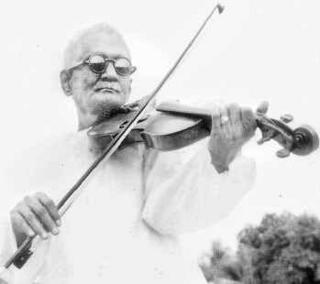
Lighting up the world of music
Violin, the early sixteenth century Italian instrument reached India in the mid-17th century through European military bands. Early Indian violinists included Vadivelu and Balu (1786-1859), brother of the great composer Muthuswami Dikshitar. By the end of the 19th century Carnatic violin solo performances by Tirukodikaval Krishna Iyer and Govindaswami Pillai became popular as the instrument was thoroughly indigenised in technique and spirit. One of the great violinists of all time was Dwaram Venkataswamy Naidu (1893-1964).
Venkataswamy, born in Bangalore, belonged to a Telugu family. His grandfather and father were commissioned army officers and his father Venkatarayudu, who played violin in the military band, settled down near Anakapalle in Andhra after retirement. As a boy Venkataswamy left school due to poor eyesight. He initially learnt violin at the age of six from his elder brother Venkatakrishnaiah and later from his brother’s teacher the great Veena vidwan Tumarada Sangameswara Sastry. Venkataswamy’s mental discipline helped him practise music for hours at a stretch. Many years later, he would warn his disciples “If you don’t practice for one day, you will notice your mistakes; if you don’t practice for two days the audience would notice your mistakes!”
Venkataswamy, a child prodigy, became an expert violin player at fourteen, winning critics’ acclaim. His attention to detail, dedication, keen grasp and intuition resulted in an extremely melodious and deceptively simple style that soon became very popular. On one occasion, the veteran Govindaswami Pillai recommended the young man as a stand-in for himself at a concert in Kakinada.
In 1919 Adibhatla Narayanadas, the multi-faceted genius and principal at the Vijayanagaram Music College appointed Naidu the professor of violin. In 1929 he was offered Music professorship at Annamalai University with good salary. But Dwaram, loyal to his patron the Raja of Vijayanagaram, declined. He succeeded Narayanadas as principal in 1936. With profound knowledge of both Indian and Western styles, he would play compositions of Mendelssohn, Bach and others for his friends.
In 1927 Dwaram made his debut in Madras through music performances that coincided with the Congress session. He regularly accompanied almost all the great vocalists of the time and performed his first solo recital at Vellore in 1938. Music critics wrote that he was too great to be a mere accompanist. A traditionalist and innovator, Venkataswamy developed a soft bowing technique combined with firm finger-play. His manodharma as well as the choice, placement and rendering of the compositions proved for the first time that violin could be as good as Veena or Nadaswaram for Carnatic music.
Dwaram’s familiarity with Hindustani music was reflected in his treatment of ragas like Subhapantuvarali, Kapi and Hindolam. Yehudi Menuhin was greatly impressed by his playing. Rabindranath Tagore, in spite of his busy schedule, sat mesmerised by his music and happily sang along with the virtuoso. Several Telugu poets wrote in praise of his music.
In 1949 Dwaram was felicitated at Madras by Governor. He performed at Delhi in 1952 in aid of the Blind Relief Association. In 1962, the President of India honoured him. Because of the war with China, all official functions had to be cancelled, but the President made an exception in this case. Later Dwaram bought a house and settled down in Madras. As an old man, he would regale little children in the neighbourhood with his violin.
Dwaram won several awards and titles including Gandharva Vidya Bhushanam, Ganakala Visarada, Sangita Kalanidhi (1941), Padma Shree (1959), Sangita Ratnakara, Kala Prapurna (1950) etc. but he never sought favours. His disciples include his daughter Mangatayaru, Marella Kesavarao, T R Mahalingam, Ammula Satyavathi and others. Statues of Venkataswamy Naidu have been erected in Vishakhapatnam and Madras. As Dr. Balamuralikrishna remarked in a TV interview, Dwaram was born for the violin.





4 Comments:
Wonderful article!! "extremely melodious and deceptively simple style" - this phrase describes Dwaram's music MOST effectively. Thanks for an informative article. I enjoyed reading your other articles also.
As a 4th-gen student of the Dwaram School of violin playing, I can definitely vouch for the bowing and fingering technique part. During many discussions we had with my Guru Sri . Ivaturi Vijayeswara Rao, it would all be about "Naidu-garu's" ideas about bowing and fingering. And ofcourse the little ingenious exercies he would undertake to improve the many aspects.
One other Dwaram who is worth mention here is the lesser known "Narasinga Rao".
Sri. Narasinga Rao's kapi clip: http://www.youtube.com/watch?v=B5aDbLcbpQM
Incidentally it was in late 70's that I first heard Heifitz's violin record at my guru's house.
Hear Mangathayaru here: http://easyjams.blogspot.com/2012/05/ms-subbulakshmi-sri-venkateswara-balaji.html
it was a great blessing for me to have learnt from smt .ammula satyavathi garu
Post a Comment
<< Home